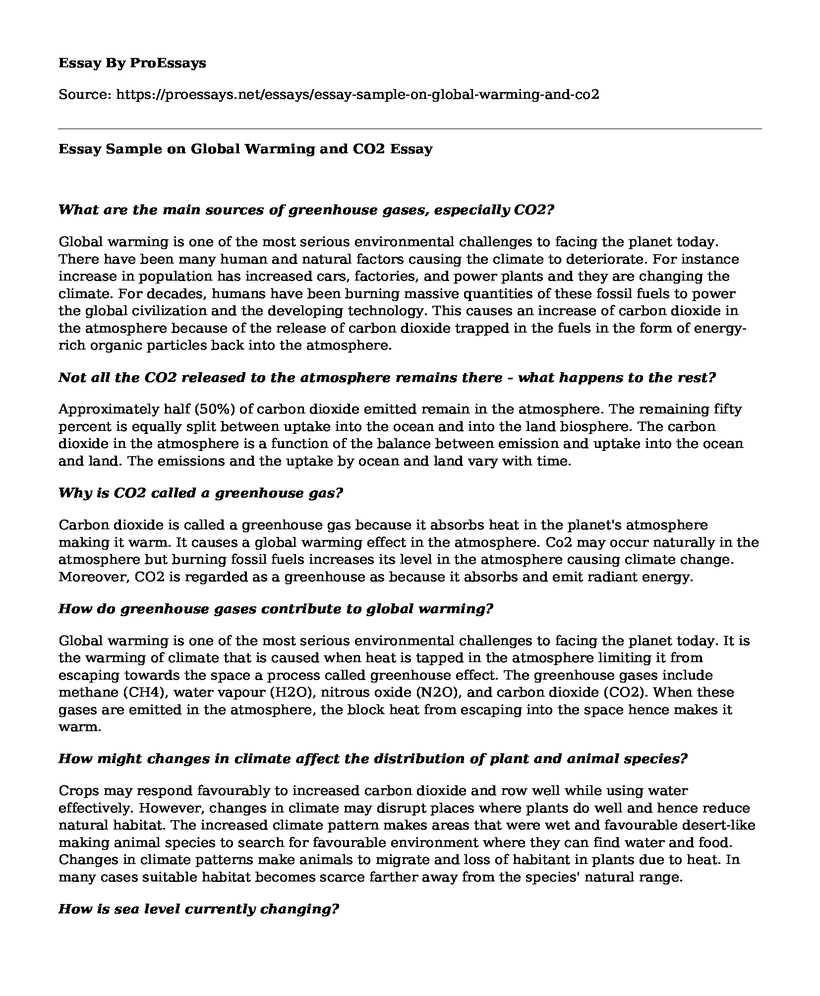What are the main sources of greenhouse gases, especially CO2?
Global warming is one of the most serious environmental challenges to facing the planet today. There have been many human and natural factors causing the climate to deteriorate. For instance increase in population has increased cars, factories, and power plants and they are changing the climate. For decades, humans have been burning massive quantities of these fossil fuels to power the global civilization and the developing technology. This causes an increase of carbon dioxide in the atmosphere because of the release of carbon dioxide trapped in the fuels in the form of energy-rich organic particles back into the atmosphere.
Not all the CO2 released to the atmosphere remains there - what happens to the rest?
Approximately half (50%) of carbon dioxide emitted remain in the atmosphere. The remaining fifty percent is equally split between uptake into the ocean and into the land biosphere. The carbon dioxide in the atmosphere is a function of the balance between emission and uptake into the ocean and land. The emissions and the uptake by ocean and land vary with time.
Why is CO2 called a greenhouse gas?
Carbon dioxide is called a greenhouse gas because it absorbs heat in the planet's atmosphere making it warm. It causes a global warming effect in the atmosphere. Co2 may occur naturally in the atmosphere but burning fossil fuels increases its level in the atmosphere causing climate change. Moreover, CO2 is regarded as a greenhouse as because it absorbs and emit radiant energy.
How do greenhouse gases contribute to global warming?
Global warming is one of the most serious environmental challenges to facing the planet today. It is the warming of climate that is caused when heat is tapped in the atmosphere limiting it from escaping towards the space a process called greenhouse effect. The greenhouse gases include methane (CH4), water vapour (H2O), nitrous oxide (N2O), and carbon dioxide (CO2). When these gases are emitted in the atmosphere, the block heat from escaping into the space hence makes it warm.
How might changes in climate affect the distribution of plant and animal species?
Crops may respond favourably to increased carbon dioxide and row well while using water effectively. However, changes in climate may disrupt places where plants do well and hence reduce natural habitat. The increased climate pattern makes areas that were wet and favourable desert-like making animal species to search for favourable environment where they can find water and food. Changes in climate patterns make animals to migrate and loss of habitant in plants due to heat. In many cases suitable habitat becomes scarce farther away from the species' natural range.
How is sea level currently changing?
Currently, sea levels continue to rise due to the increased level of carbon dioxide emissions. Since 1900 to 1800 heat expansion continue to increase up to 42% of sea level. This means that the sea level in raisin from 3.0 to 7.3 from 1900 to 2018.
Cite this page
Essay Sample on Global Warming and CO2 . (2022, Nov 17). Retrieved from https://proessays.net/essays/essay-sample-on-global-warming-and-co2
If you are the original author of this essay and no longer wish to have it published on the ProEssays website, please click below to request its removal:
- Perdue Chicken Factory Essay
- The Profitability of Steam Boating on Western Rivers: 1850 Essay
- Essay on United States Influence on Global Warming and the International Solution
- Essay Example on Ecological Grief: Science Journalists Examine Climate Change
- Essay Example on Industrial Pollution: A Business Problem Facing Manufacturing Industries
- Air Pollution & Children's Health - Essay Sample
- Essay Example on Fossil Fuels: A Global Challenge for Climate Change







